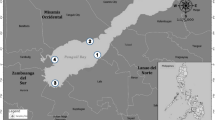Abstract
The gastropod Polinices sordidus was collected from an uncontaminated area in Quibray Bay, New South Wales, Australia, in 1990. The snails were exposed for 2 wk to polluted sediments collected from Port Kembla Harbour, Blackwattle Bay, Lake Illawarra, Lake Macquarie in New South Wales, Australia, and the Derwent River in Tasmania, Australia. Metal accumulation and regulation by this species were evaluated. Metal concentrations in snail tissues and total, EDTA and HCl-extractable metals in the sediments were compared. Copper concentrations were extremely varied in snails exposed to the same sediment. This was not the case for other matals tested. No accumulation of copper was found in snails exposed to different sediments. There was no zinc accumulation from sediments containing less then 10 mg Zn/g. P. sordidus could accumulate lead, manganese and iron from some of the sediments. Manganese concentrations in the snail tissues correlated with total, HCl-extractable and, more significantly, EDTA-extractable Mn in the sediments. P. sordidus was not considered to be a good bioindicator of copper and zinc contaimination in sediments; however, this species could be used as an indicator of lead and manganese contamination.
Similar content being viewed by others
Literature cited
Anderlini, V. C. (1974). The distribution of heavy metals in the red abalone, Haliotis rufescens, on the California coast. Archs envir. Contam. Toxic. 2: 253–265
Batley, G. E. (1987). Heavy metal speciation in waters, sediments and biota from Lake Macquarie, NSW. Aust. J. mar. Freshwat. Res. 38: 491–606
Betzer, S. B., Pilson, M. E. Q. (1975). Copper uptake and excretion by Busycon canaliculatum L. Biol. Bull. mar. biol. Lab., Woods Hole 148: 1–15
Bryan, G. W., Hummerstone, L. G. (1986). Zinc regulation in the Lobster Homarus gammarus: importance of different pathways of absorption and excretion. J. mar. biol. Ass. U.K. 66: 175–199
Bryan, G. W., Potts, G. W., Forster, G. R. (1977). Heavy metals in the gastropod mollusc Homarus tuberculata (L.). J. mar. biol. Ass. U.K. 57: 379–390
Förstner, U., Wittmann, G. T. W. (1981). Metal pollution in the aquatic environment. 2nd edn. Springer-Verlag, Berlin
Hughes, J. M., Chapman, H. F., Kitching, R. L. (1987). Effects of sublethal concentrations of copper and freshwater on behaviour in an estuarine gastropod Polinices sordidus. Mar. Pollut. Bull. 18: 127–131
Ireland, M. P., Wootton, R. J. (1977). Distribution of lead, zinc, copper and manganese in the marine gastropods around the coast of Wales. Envir. Pollut. 12: 27–41
Langston, W. J. (1972). Distribution of mercury in British estuarine sediments and its availability to deposit-feeding bivalves. J. mar. biol. Ass. U.K. 62: 667–684
Luoma, S. N. (1983). Bioavailability of trace metals to aquatic organisms — a review. Sci. total Envir. 28: 1–22
Luoma, S. N. (1989). Can we determine the biological availability of sediment-bound trace elements? Hydrobiologia. 176/177: 379–396
Luoma, S. N., Bryan, G. W. (1978). Factors controlling the availability of sediment-bound lead to the estuarine bivalve Scrobicularia plana. J. mar. biol. Ass. U.K. 58: 793–802
Luoma, S. N., Bryan, G. W. (1982). A statistical study of environmental factors controlling concentrations of heavy metals in the burrowing bivalve Scrobicularia plana and polychaete Nereis diversicolar. Estuar., cstl Shelf Sci. 15: 95–108
Luoma, S. N., Jenne, E. A. (1977). The availability of sedimentbound cobalt, silver and zinc to a deposit-feeling clam. In: Wildung, R. E., Drucker, H. (eds.) The biological implications of metals in the environment. National Technical Information Services, Springfield, Virginia, USA, p. 213–231. (CONF-750929)
Martoja, M., Tue, V. T., Elkaim, B. (1980). Bioaccumulation de cuivre chez Littorina littorea (L.) (gasteropode prosobranche): signification physiologique et ecologique. J. exp. mar. Biol. Ecol. 43: 251–270
Mason, A. Z., Simkiss, K. (1983). Interactions between metals and their distribution in tissues of Littorina littorea (L.) collected from clear and polluted sites. J. mar. biol. Ass. U.K. 63: 661–672
Phillips, D. J. H. (1980). Quantitative aquatic biological indicators. Applied Science Publishers Ltd., London
Rainbow, P. S. (1990). Heavy metal levels in marine invertebrates. In: Furness, R. W., Rainbow, P. S. (eds) Heavy metals in the marine environment. CRC Press, Inc. Boca Raton, Florida, p. 67–80
Rainbow, P. S., Phillips, D. J. H., Depledge, M. H. (1990). The significance of trace metal concentrations in marine invertebrates. Mar. Pollut. Bull. 21: 321–324
Ray, S., McLeese, D. W., Peterson, M. R. (1981). Accumulation of copper, zinc, cadmium and lead from two contaminated sediments by three marine invertebrates — a laboratory study. Bull. envir. Contam. Toxic. 26: 315–322
Rendell, P. S., Batley, G. E., Cameron, A. J. (1980). Adsorption as a control of metal concentrations in sediment extracts. Envir. Sci. Technol. 14: 314–318
Tessier, A., Campbell, P. G. C. (1990). Partitioning of trace metals in sediments and its relationship to their accumulation in benthic organisms. In: Guer, S., Adams, F. D., Izdar, E., Klockow, D. (eds.) Metal speciation in the environment. Springer-Verlag, Berlin, p. 545–569
Tessier, A., Campbell, P. G. C., Anclair, J. C. (1983). Relationship between trace metal partitioning in sediments and their bioaccumulation in fresh pelecypods. In: Proceedings of Fourth International Conference on Heavy Metals in the Environment. CEP Consultants Ltd., Edinburgh, Scotland, p. 1086–1089
Tessier, A., Campbell, P. G. C., Bisson, M. (1979). Sequential extraction procedure for the speciation of particulate trace metals. Analyt. Chem. 51: 844–851
Ying, W., Batley, G. E., Ahsanullah, M. (1992). The ability of sediment extractants to measure the bioavailability of metals to three marine invertebrates. Sci. total Envir. 125: 67–84
Ying, W., Batley, G. E., Ahsanullah, M. (1993). Metal bioavailability to soldier crab Mictyris longicarpus. Sci. total Envir. (in press)
Young, M. L. (1977). The transfer of 65Zn and 59Fe along a Fucus serratus (L.)-Littorina obtusata (L.) food chain. J. mar. biol. Ass. U.K. 55: 583–610
Author information
Authors and Affiliations
Additional information
Communicated by G. F. Humphrey, Sydney
Rights and permissions
About this article
Cite this article
Ying, W., Ahsanullah, M. & Batley, G.E. Accumulation and regulation of heavy metals by the intertidal snail Polinices sordidus . Marine Biology 116, 417–422 (1993). https://doi.org/10.1007/BF00350058
Received:
Accepted:
Issue Date:
DOI: https://doi.org/10.1007/BF00350058




